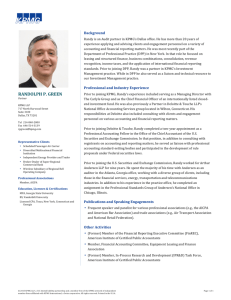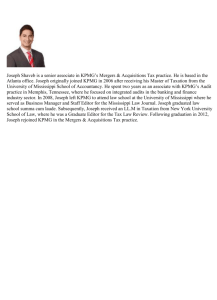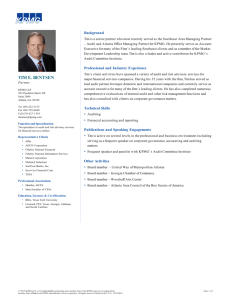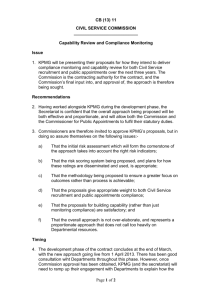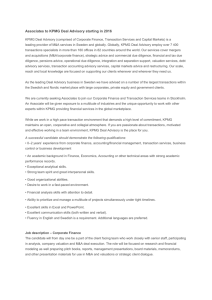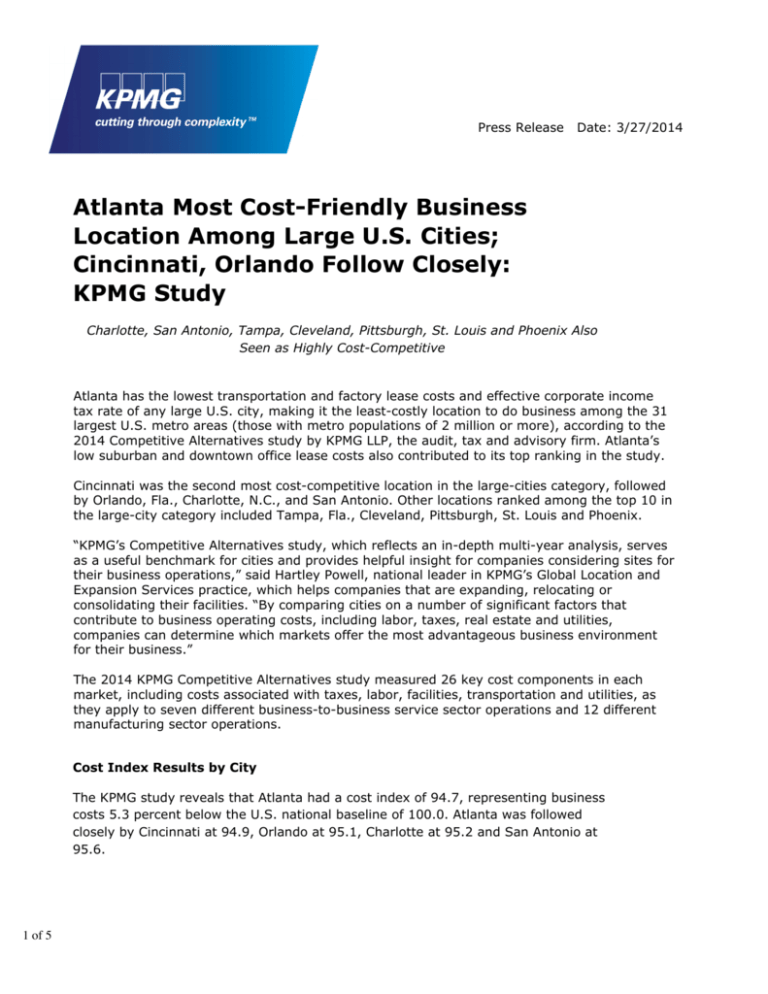
Press Release
Date: 3/27/2014
Atlanta Most Cost-Friendly Business
Location Among Large U.S. Cities;
Cincinnati, Orlando Follow Closely:
KPMG Study
Charlotte, San Antonio, Tampa, Cleveland, Pittsburgh, St. Louis and Phoenix Also
Seen as Highly Cost-Competitive
Atlanta has the lowest transportation and factory lease costs and effective corporate income
tax rate of any large U.S. city, making it the least-costly location to do business among the 31
largest U.S. metro areas (those with metro populations of 2 million or more), according to the
2014 Competitive Alternatives study by KPMG LLP, the audit, tax and advisory firm. Atlanta’s
low suburban and downtown office lease costs also contributed to its top ranking in the study.
Cincinnati was the second most cost-competitive location in the large-cities category, followed
by Orlando, Fla., Charlotte, N.C., and San Antonio. Other locations ranked among the top 10 in
the large-city category included Tampa, Fla., Cleveland, Pittsburgh, St. Louis and Phoenix.
“KPMG’s Competitive Alternatives study, which reflects an in-depth multi-year analysis, serves
as a useful benchmark for cities and provides helpful insight for companies considering sites for
their business operations,” said Hartley Powell, national leader in KPMG’s Global Location and
Expansion Services practice, which helps companies that are expanding, relocating or
consolidating their facilities. “By comparing cities on a number of significant factors that
contribute to business operating costs, including labor, taxes, real estate and utilities,
companies can determine which markets offer the most advantageous business environment
for their business.”
The 2014 KPMG Competitive Alternatives study measured 26 key cost components in each
market, including costs associated with taxes, labor, facilities, transportation and utilities, as
they apply to seven different business-to-business service sector operations and 12 different
manufacturing sector operations.
Cost Index Results by City
The KPMG study reveals that Atlanta had a cost index of 94.7, representing business
costs 5.3 percent below the U.S. national baseline of 100.0. Atlanta was followed
closely by Cincinnati at 94.9, Orlando at 95.1, Charlotte at 95.2 and San Antonio at
95.6.
1 of 5
Cincinnati has the lowest overall facility costs among the 31 large cities, even
though it doesn’t rank first for any of the three types of facilities examined. It
also boasts the lowest property tax costs, as well as relatively low salary and
wage costs.
Orlando has the lowest overall labor costs, helped by low costs for statutory
plans and benefits.
Charlotte, new to the study this year, has competitive labor costs and factory
lease costs.
San Antonio, also new to the report, has the lowest salary and wage costs, as
well as very low costs for both natural gas and electricity.
Tampa, with a cost index of 95.8, has the third-lowest labor costs among the
31 large cities.
Cleveland, at 96.3, ranks second among the large cities studied for low
effective corporate income-tax rate, and also has relatively low statutory labor
costs.
Pittsburgh, at 96.4, offers relatively low salary and wage costs and very low
property tax costs.
St. Louis, at 96.6, has the lowest electricity costs among the 31 large cities,
and also a relatively low effective corporate income tax rate.
Phoenix (96.7) rounded out the top 10 in the large cities category, offering low
office lease costs, both suburban and downtown, and relatively low statutory
labor costs.
New York City and San Francisco, in contrast to the most cost-friendly cities, represent the
most expensive large U.S. cities in which to do business, with cost indexes of 103.6 and
104.2, respectively. Despite many cost disadvantages, New York City did score well in the
transportation category, with the second lowest costs among all 31 large cities, while San
Francisco has below-average costs for natural gas and property-based taxes.
Other Factors Influence Site Selection
“Clearly business costs are a major component of the site-selection process for any
company, yet organizations should make sure that they also take into account non-cost
factors such as labor availability and skills, economic conditions, infrastructure, innovation,
regulatory environment, cost of living and quality of life,” said KPMG’s Powell. “The KPMG
Competitive Alternatives study addresses these additional areas as well, providing useful
perspective for organizations going through the site-selection process.”
Cost indexes for the 31 large U.S. cities follow. The baseline cost index (U.S. = 100.0) is
defined as the average business costs in the four largest U.S. metropolitan areas: New York,
Los Angeles, Chicago and Dallas-Fort Worth.
2 of 5
KPMG’s 2014 COMPETITIVE ALTERNATIVES STUDY
(U.S. Cities with population more than 2 million)
Cost
Index
Rank
Cost
Index
Rank
Atlanta, GA
94.7
1
Detroit, MI
98.2
17
Cincinnati, OH
94.9
2
Minneapolis, MN
98.2
18
Orlando, FL
95.1
3
Las Vegas, NV
98.2
19
Charlotte, NC
95.2
4
Denver, CO
98.4
20
San Antonio,
TX
95.6
5
Riverside-San
Bernardino, CA
98.7
21
Tampa, FL
95.8
6
Chicago, IL
99.1
22
Cleveland, OH
96.3
7
Philadelphia, PA
99.4
23
Pittsburgh, PA
96.4
8
Sacramento, CA
99.5
24
St. Louis, MO
96.6
9
San Diego, CA
99.9
25
Phoenix, AZ
96.7
10
North Virginia,
Metro DC
100.1
26
Kansas City,
MO
96.8
11
Los Angeles, CA
100.5
27
Dallas-Fort
Worth, TX
96.8
12
Boston, MA
101.1
28
Miami, FL
97.0
13
Seattle, WA
101.4
29
Baltimore, MD
97.1
14
New York City,
NY
103.6
30
Houston, TX
98.0
15
San Francisco, CA 104.2
31
Portland, OR
98.1
16
City
Cost-index figures were created by measuring the combined impact of 26 cost components
that are most likely to vary by location. More than 2,000 individual business scenarios
were examined, analyzing more than 50,000 items of data.
3 of 5
These results are part of KPMG’s global 2014 Competitive Alternatives study, which
measured business operating costs in more than 100 cities in 10 countries. The
complete 2014 global study is available online at www.competitivealternatives.com.
Cost-index figures were created by measuring the combined impact of 26 cost
components that are most likely to vary by location. More than 2,000 individual
business scenarios were examined, analyzing more than 50,000 items of data.
These results are part of KPMG’s global 2014 Competitive Alternatives study, which
measured business operating costs in more than 100 cities in 10 countries. The
complete 2014 global study is available online at www.competitivealternatives.com.
About KPMG LLP
KPMG LLP, the audit, tax and advisory firm (www.kpmg.com/us), is the U.S. member
firm of KPMG International Cooperative (“KPMG International”). KPMG International’s
member firms have 155,000 professionals, including more than 8,600 partners, in
155 countries.
Contact:
Bridget Carroll/Robert Nihen
KPMG LLP
201-505-6501/201-307-8296
bccarroll@kpmg.com/
rnihen@kpmg.com
© 2015 KPMG LLP, a Delaware limited liability partnership and the U.S. member firm of the
KPMG network of independent member firms affiliated with KPMG International Cooperative
("KPMG International"), a Swiss entity. All rights reserved.
KPMG International Cooperative (“KPMG International”) is a Swiss entity. Member firms of
the KPMG network of independent firms are affiliated with KPMG International. KPMG
International provides no client services. No member firm has any authority to obligate or
bind KPMG International or any other member firm vis-à-vis third parties, nor does KPMG
International have any such authority to obligate or bind any member firm.
4 of 5

